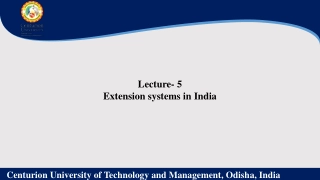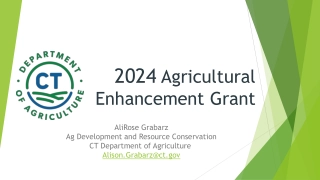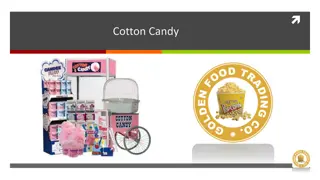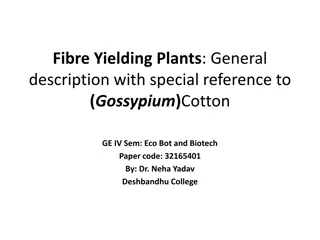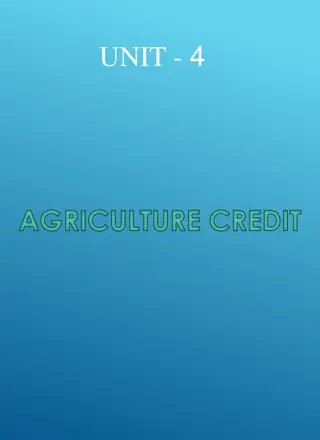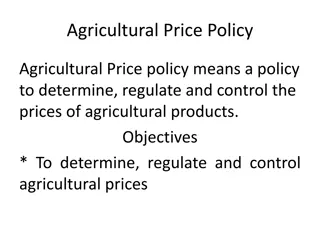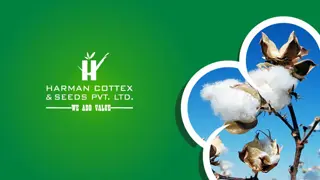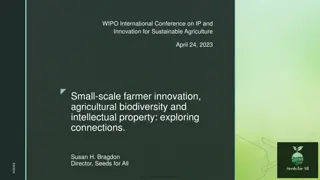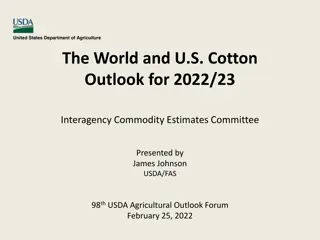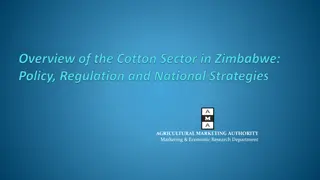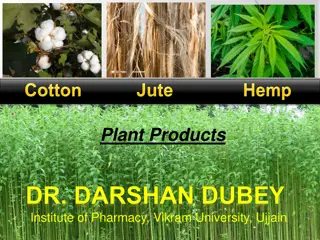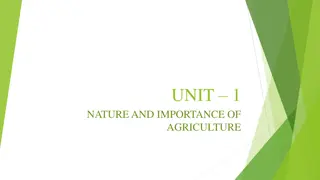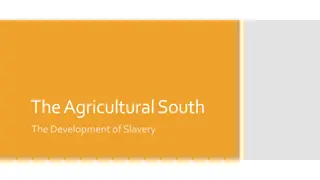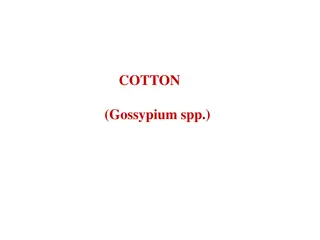Enhancing Cotton Technologies for Sustainable Agricultural Development in India
This paper presents the past experiences, present endeavors, and future efforts in transferring cotton technologies towards science-led sustainable development in India. It discusses the challenges, successes, and lessons learned in the context of the Indian cotton scenario. The ultimate goal is to strengthen and improve cotton extension services in the country, with insights valuable for the Middle East and Mediterranean regions as well. The content touches on agricultural development in India, the agricultural extension system, and the state of cotton technology transfer in the country. The paper was presented at the 13th meeting of the ICAC Inter-Regional Cooperative Research Network on Cotton in Luxor, Egypt.
Download Presentation

Please find below an Image/Link to download the presentation.
The content on the website is provided AS IS for your information and personal use only. It may not be sold, licensed, or shared on other websites without obtaining consent from the author.If you encounter any issues during the download, it is possible that the publisher has removed the file from their server.
You are allowed to download the files provided on this website for personal or commercial use, subject to the condition that they are used lawfully. All files are the property of their respective owners.
The content on the website is provided AS IS for your information and personal use only. It may not be sold, licensed, or shared on other websites without obtaining consent from the author.
E N D
Presentation Transcript
Past Experiences, Present Endeavors and Future Exertions in Transfer of Cotton Technologies towards Science- led Sustainable Development in India Usha Rani Joshua Principal Scientist (Agricultural Extension) & Prakash, A.H., Project Coordinator (Cotton Improvement) ICAR Central Institute for Cotton Research, Regional Station, Coimbatore 641 003 Tamil Nadu, India +91 98432 98422 ushajoshua@rediffmail.com 13th meeting of the ICAC Inter-Regional Cooperative Research Network on Cotton for the Mediterranean and Middle East Regions at Luxor, Egypt during 2-6, February 2018
Content Ultimate objective of the paper Agricultural Development in India Agricultural Extension System in India Indian Cotton Scenario Cotton TOT in India Past Experiences Present Endeavors Future Exertions Challenges ahead Future Perspectives Lessons for Mid East and Mediterranean regions Conclusion Ultimate objective of the paper Agricultural Development in India Agricultural Extension System in India Indian Cotton Scenario Cotton TOT in India Past Experiences Cotton TOT Present Endeavors - - Cotton TOT Future Exertions Cotton TOT Challenges ahead Future Perspectives Lessons for Mid East and Mediterranean regions Conclusion Cotton TOT Cotton TOT Cotton TOT 13th meeting of the ICAC Inter-Regional Cooperative Research Network on Cotton for the Mediterranean and Middle East Regions at Luxor, Egypt during 2-6, February 2018
There is only one thing more painful than learning from experience and that is not learning from experience - Archibald McLeish American Poet and Writer 13th meeting of the ICAC Inter-Regional Cooperative Research Network on Cotton for the Mediterranean and Middle East Regions at Luxor, Egypt during 2-6, February 2018
To gain a view on what works where and why in transferring cotton technologies in order to identify the new measures that strengthen and improve cotton extension service in India The ultimate objective of this paper .. 13th meeting of the ICAC Inter-Regional Cooperative Research Network on Cotton for the Mediterranean and Middle East Regions at Luxor, Egypt during 2-6, February 2018
Agricultural Development in India From food shortages and import To self-sufficiency and exports Geographical area 328.73 m ha Population 1210 million Total Cultivators + agricultural laborers 263.1 million Gross Cropped Area - 200.86 m ha Average size of land holding 1.15 ha India is among top 3 global producers in - Wheat, Rice, Pulses, Cotton, Peanuts, Fruits & Vegetables World s largest herds of buffalo and cattle Livestock population is in India World s largest producer of milk One of the largest & fastest growing poultry sectors in the world Agriculture development is a state subject Union Government play a major role in formulation of Policies, Programmes and Budgetary Support From subsistence farming To intensive and technology led cultivation. Today , India is the front ranking producer of many crops in the world. Ushered in through the green, white, blue and yellow revolutions
Agricultural Extension System in India National Level State Level Other Extension System Public Extension System Public Extension System Commodity Boards Non Government Organizations Financial Institutions Central Ministry of Agriculture, Cooperation and Farmers Welfare State Ministry of Agriculture, Horticulture, Animal Husbandry, Fisheries, etc., Indian Council of Agricultural Research State Agricultural Universities Indian Council of Agricultural Research (ICAR) is an apex body at the national level to evolve effective Transfer of Technology (TOT) models. State Agricultural Universities (SAUs) come out with viable models that can be replicated through existing extension machinery besides implementing models evolved by ICAR system.
Indian Cotton Scenario Indian Cotton Scenario Cotton is the second largest Kharif crop of the country, after Rice contributing 6-7% of the net sown area. India has the pride of cultivating all the four cultivated species Cotton Indian economy as the country's textile industry is predominantly Cotton based. plays an important role in the India is leading in area and production of cotton at world level Productivity of Cotton Is our major concern for Research, Development and TOT Towards increasing the Productivity only all our TOT programs are framed out.
Cotton Extension System in India Cotton Extension System in India ICAR ICAR CICR & AICRP on Cotton CICR & AICRP on Cotton Central Ministry of Agriculture, Cooperation and Farmers Welfare Government of India Private Industries through CSR SAUs SAUs KVKs KVKs Directorate of Cotton Development Directorate of Cotton Development Non Government / Voluntary Organizations Individual State Ministry of Agriculture
Past Experiences Until cotton The province 1840 was Until the cotton the middle middle of of the the 18 18th th Century Century only only arboreum arboreum and and herbaceum herbaceum varieties varieties of of Pre Independence Period The first province but 1840- -1842 was the first attempt but it it was 1842 A A. .D D and the introduction attempt was was in in 1790 was not and in in 1846 1790 A A. .D D to to grow not successful 1846 AD Cambodia variety grow American Then AD at at Punjab variety in in 1904 American Cotton Then tried Punjab. . The 1904- -05 Cotton in in Bombay tried in in Deccan, The most 05. . Bombay & & Madras Deccan, Konkon most significant Madras Hubli in in development successful. . Konkon, , Hubli significant development introduction of of Cambodia Before 1947 Setting the Setting up the spread up of of Indian spread of of hirsutum Indian Cotton hirsutum & & long Cotton Committee long staple Committee (ICC) staple cotton (ICC) in in 1917 cotton in in India 1917 at at Bombay India. . Bombay further further boosted boosted It It established statutory Laboratory established Indian statutory Body Laboratory (CTRL) Indian Central Body in in 1923 (CTRL) in in 1924 Central Cotton 1923 and 1924 at at Bombay Cotton Committee and established Bombay. . Committee (ICCC) established Central (ICCC) in in 1921 Central Technological 1921 and Technological Research and it it became became a a Research Since quantitatively Since 1924 quantitatively & & qualitatively 1924 to to 1966 1966, , many qualitatively helped many cotton cotton schemes helped to to double schemes formulated double the formulated by the production ICCC to to improve production during by ICCC improve cotton during 1966 cotton 1966. .
44 percent increase in cotton area 55 percent increase in production during the 1st Plan Period (1951-52 to 1955- 56), Cotton Extension Scheme and Grow More Cotton campaigns sponsored by the Government of India 1950-51 Post Independence 24 percent increase due to increased productivity during 2nd Plan Period (1956-57 to 1960-61) Phase I 1947-1969 competition from other crops was the challenge 12 % increase in production during third plan period (Due to increase in area and yield) Intensive Cotton Cultivation Scheme (ICCS), popularly known as Package Programme , was launched in 1962-63 (special field staff were appointed for dissemination of technical knowledge to farmers, besides providing incentives (Seed, Pesticides, Appliances, Operational cost, Ceiling prices etc.). Severe drought was the challenge 5.497 m bales by the end of 1968-69
ICCC was abolished and transferred to ICAR All India Coordinated Cotton Improvement Project in 1967 Post Independence Era Intensive Cotton Development Program (ICDP) 1979-80 1969-1990 Phase II Cotton Corporation of India in 1970 The area was increased to 7.196 m ha and production was 8.436 m bales and the average yield was 198 kg/ha
Technology Mission on Cotton 1999- 2014 Post Independence Era National Food Security Mission Commercial crops (2014 to till date) 1991-2017 Phase III The area was increased to 11.86 m ha and production was 33.34 m bales and the average yield was 481 kg/ha
Present Endeavors Traditional ICT based Large Scale Demonstrations E-Kapas Network 13th meeting of the ICAC Inter-Regional Cooperative Research Network on Cotton for the Mediterranean and Middle East Regions at Luxor, Egypt during 2-6, February 2018
Large Scale Demonstrations Cotton Large Scale Demonstrations - - Front Line Demonstrations on Cotton Front Line Demonstrations on Seeing is believing is the principle Seeing is believing is the principle The under of of the System Demonstration The field under the the National System Demonstration (FLD) field demonstration the close National Agriculture is is (FLD). . demonstration conducted close supervision Agriculture Research called conducted scientists Research Front supervision of of scientists called Front Line Line Yield enhancement is the motive Yield enhancement is the motive This implemented in in 1996 crop to to demonstrate through All Project (AICRP) working centres This implemented crop through Project working programme 1996- -97 cotton technologies India Coordinated (AICRP) on centres. . novel novel programme 97 for was was for cotton technologies Research and its cotton demonstrate cotton All India on cotton Coordinated Research cotton and its net net
Front Line Demonstration (FLD) in Cotton Until 2017, more than 20000 FLDs were conducted in the ten cotton growing states of India. Until 2013, these demonstrations were conducted on Production Technology, Integrated Pest Management and on Farm implements under Technology Mission on Cotton, Mini Mission II. For the past three years, under the National Food Security Mission (NFSM), these demonstrations are being conducted on ICM, Desi/ELS /Seed production and intercropping An average of 18.70 percent increase in the seed cotton yield was observed in the demonstration field compared to farmers practice
Special features of FLD Special features of FLD Dissemination of good cultivation practices Farmers to farmers technology dissemination Yield enhancement Reduction in cost of cultivation Inclusive development Scientists End users linkage Direct feed back from the clientele system to the research system
Challenges in FLD Challenges in FLD Scientists conduct the demonstration Pros and Cons Meager inclusion of modern Information and Communication Technology (ICT) tools Meager inclusion of other extension innovations
ICT based - e-Kapas Network The project was functioning under Technology Mission on Cotton-Mini Mission I, a novel approach of the Government of India, to increase the productivity of cotton in the country. The project has been functioning in 17 centres across the ten cotton growing states of the country under the leadership of Central Institute for Cotton Research, Nagpur. Farmers interested in e-Kapas network register with their local state centres by registering their mobile numbers. Centres send regular Voice SMS about cotton genotypes, production and protection technologies along with weather and market reports in their local languages to the registered growers. Under e-Kapas Network project, around 0.5 million cotton growers in the country had registered as beneficiaries and developed a data base of e-Kapas network beneficiaries. Until February 2017, more than 14.00 million voice SMS alerts were sent to the e-Kapas beneficiaries.
Weekly voice SMS during the entire crop season, weekly advisory through website for knowing the do s and don ts in cotton cultivation e e- -Kapas Kapas Around 0.5 million farmers >14 million voice Around 0.5 million farmers >14 million voice sms sms www.cicr.org.in www.cicr.org.in
Decision Support System for selecting a suitable cotton variety / hybrid Decision Support System for selecting a suitable cotton variety / hybrid CICR Scientists had developed a DSS for selecting a suitable cotton variety / hybrid suited to their locations CICR Scientists had developed a DSS for selecting a suitable cotton variety / hybrid suited to their locations
Mobile apps to know the strategies to manage the pests and diseases CICR Scientists had app for Pest Management in cotton CICR Scientists had developed a mobile app for Pest Management in cotton developed a mobile That can be used in cotton cultivation That can be used for managing the pests in cotton cultivation for managing the pests
Challenges faced in these individual TOT efforts - Increasing the productivity in cotton is always a concern Extension programs are blamed for the yield gap All TOT programs are not successful all the times Dependent of sponsorships Not always farmer friendly Not always inclusive Lack of extension innovations Study say that cotton TOT programs are having medium level of women friendliness There are few programs which are best and farmer friendly programs But they are all scattered and attempted independently - - - - - - - - -
Future Exertions 1. As like package of technical practices in cotton, an integrated package of best TOT practices to be adopted step by step chronologically during various stages of cotton cultivation either by the change agents or by the farmers to deliver or get extension support for doubling the yield and income from cotton cultivation. Why not an Integrated approach to be followed in Management of Extension or TOT mechanisms????
Proposed Synergistic TOT approach for Profitable and Sustainable Cotton Cultivation in India by CICR The proposed synergistic TOT approach for profitable and sustainable cotton production in India will be a convergence of all customary and contemporary extension methods tailored for cultivation of cotton crop in India. It includes, Decision Support System for selecting a suitable variety / hybrid, Front Line Demonstration for cultivating a new variety / hybrid, Soil sampling and soil health card before land preparation, A booklet with entire package of practices for ready reference during cultivation, Weekly voice SMS during the entire crop season, Weekly advisory through website for knowing the do s and don ts in cotton cultivation, Short duration video films to accurately understand a particular technology, Using Whatsapp group for clarifying the suddenly occurring pests / diseases / disorders, Mobile apps to know the strategies to manage the pests and diseases, Method demonstration to disseminate the best harvesting and post harvesting practices, Market intelligence to sell the seed cotton for the best price, Personal field visits by the Scientists and Exposure visits by the farmers to see and believe the advantages of technologies, Specialized training programs to improve the skill and Radio broadcast and video telecast for spreading the success of this package to mass farmers.
2. TOT approach.towards Science- led Sustainable Development in India is the aim .. Developing TOT Models that address Water Use / Input Use Efficiency Precision Farming Good Practices Bringing down the cost of production Robotics, autonomous and intelligent machines to share information and labor in cotton farming Novel structured buy back system
Future Exertions 3. As like Sugarcane cultivation in India, TOT through Industries may be attempted Why not TOT through Cotton Industries in India?
Challenges Ahead developing a new TOT innovation for cotton in India Issues due to negative impact of Bt cotton Cultivation viz., new emerging pests and diseases Imbalance in the staple length wise lint supply Sustainability issues Traceability issues Labor Issues
Way Forward. Development of field tested and refined package of Best Farmer Friendly Transfer of Technology Practices through convergence of all customary and contemporary extension methods tailored for cultivation of cotton crop Development of a TOT model to transfer technologies through Industries.
Concluding Suggestion Concluding Suggestion Replicating the success of proven cotton TOT models adopted in India viz., Front Line Demonstrations and e-Kapas network may be attempted in other need based Middle East cotton growing countries .
Acknowledgement Acknowledgement Sincere thanks to 1. Dr. Kai Hughes, Executive Director and Dr. K. R. Kranthi, Head Technical Section, ICAC 2. The Organizing committee of 13th Meeting Prof. Negm and Dr. Susan, Egypt 3. The ICAR and the Director, ICAR-CICR, Nagpur 4. The Project Coordinator and Head, ICAR- CICR, Coimbatore


